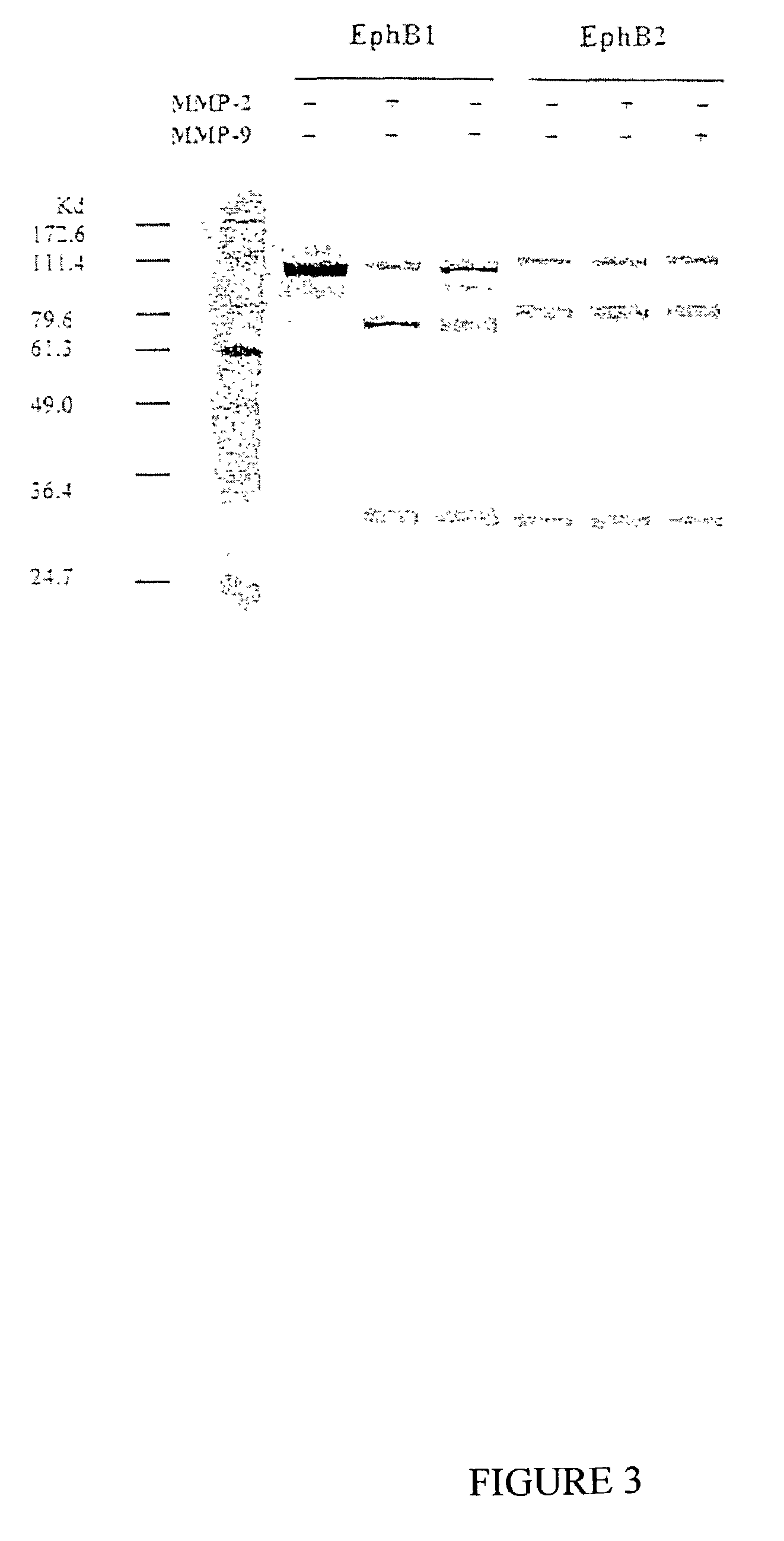Selective substrates for matrix metalloproteinases
a matrix metalloproteinase and selective substrate technology, applied in the field of biochemistry and molecular medicine, can solve the problems of not always available binding molecules with sufficient affinity and selectivity, drug wide-spectrum metalloproteinase inhibitors, unwanted side effects,
- Summary
- Abstract
- Description
- Claims
- Application Information
AI Technical Summary
Benefits of technology
Problems solved by technology
Method used
Image
Examples
example i
Construction of the Phase Library
[0143]The fUSE5 polyvalent phage display vector was modified to express random hexamers at the amino terminus of the gene111 protein, and an octapeptide FLAG epitope at the amino-terminal end of the random hexamers. The FLAG epitope was engineered at the N-terminus of the geneIII protein by annealing oligonucleotides CCGGGTTTGTCGTCGTCGTCTTTGTAGTCGGTAC (SEQ ID NO:111) and CGACTACAAAGACGACGACGACAAAC (SEQ ID NO:112) and ligating them into fUSE5 at the Kpn I and Xba I restriction sites. The random hexamers were generated by PCR extension of the template oligonucleotide GGGGAGGCCGACGTGGCCGTCATCAGGCGGCTCAGGC (NNK) 6ACGGCCTCTGGGGC CGAAAC (SEQ ID NO:113), where N is any nucleotide and K is either G or T. The template oligonucleotide also encodes an SGGSG (SEQ ID NO:114) linker position in between the FLAG epitope and the random hexamer. A primer oligonucleotide AATTTCTAGTTTCGGCCCCAGAGGC (SEQ ID NO:115) and the template oligonucleotide were mixed and heated a...
example ii
MMP-2 Selective Substrate Polypeptide
[0144]The substrate phage library used for MMP-2 selective substrate polypeptide detection had 2.4×108 individual sequences, ensuring with 75% confidence that all possible sequences are represented.
[0145]Recombinant MMP-2 was generated in a manner similar to that we have previously reported for MMP-9 (Kridel, et al., J. Biol. Chem. 276:20572-20578 (2001)). Briefly, the cDNA encoding the catalytic domain of MMP-2 was generated by PCR and cloned into the pCDNA3 expression vector (Invitrogen) and used to transfect HEK 293 cells. Individual antibiotic resistant clones were isolated with cloning rings, expanded, and then screened by RT-PCR and zymography. The catalytic domains of MMP-2 and 9 were purified from the conditioned medium by gelatin-Sepharose chromatography. We also employed an additional purification by ion exchange on Q-Sepharose to obtain greater purity. Fractions containing MMP-2 or 9 were concentrated in a dialysis bag against Aquacide...
example iii
MMP-9 Selective Substrate Polypeptides
Selection of peptide substrates for MMP-9
[0155]Optimal substrates were selected by exposing the phage library to a recombinant form of the catalytic domain of MMP-9 expressed in HEK 293 cells. The recombinant catalytic domain of MMP-9 was purified on gelatin-Sepharose followed by ion exchange chromatography. The protease was activated as described for MMP-2 in Example II. Phage selections were performed with 2.5 mg / ml (56 nM) of active MMP-9. Following three rounds of exposure to MMP-9, individual phage clones were selected for sequencing. An alignment of the motifs revealed three groups of structurally distinct substrates (Table I). One group of substrates contain the motif with sequence Pro-X-X-XHy-Ser / Thr (SEQ ID NO:123). Further analysis shows that within this larger motif, Arg is favored at P2 and Ser / Thr is favored at P1. Other groups of substrates contained a Gly-Leu-Lys / Arg (SEQ ID NO:124) motif, a Arg-Arg-XHy-Leu (SEQ ID NO:125) motif, ...
PUM
| Property | Measurement | Unit |
|---|---|---|
| emission wavelength | aaaaa | aaaaa |
| excitation wavelength | aaaaa | aaaaa |
| diameter | aaaaa | aaaaa |
Abstract
Description
Claims
Application Information
 Login to View More
Login to View More - R&D
- Intellectual Property
- Life Sciences
- Materials
- Tech Scout
- Unparalleled Data Quality
- Higher Quality Content
- 60% Fewer Hallucinations
Browse by: Latest US Patents, China's latest patents, Technical Efficacy Thesaurus, Application Domain, Technology Topic, Popular Technical Reports.
© 2025 PatSnap. All rights reserved.Legal|Privacy policy|Modern Slavery Act Transparency Statement|Sitemap|About US| Contact US: help@patsnap.com



